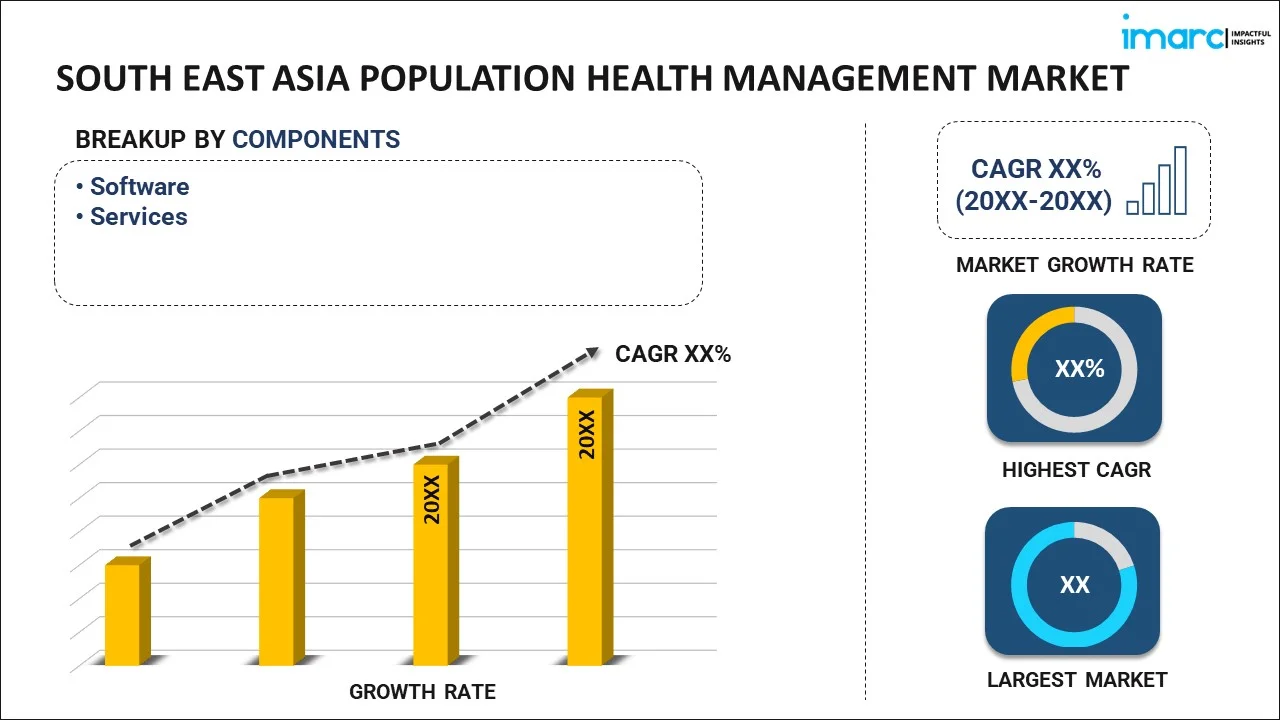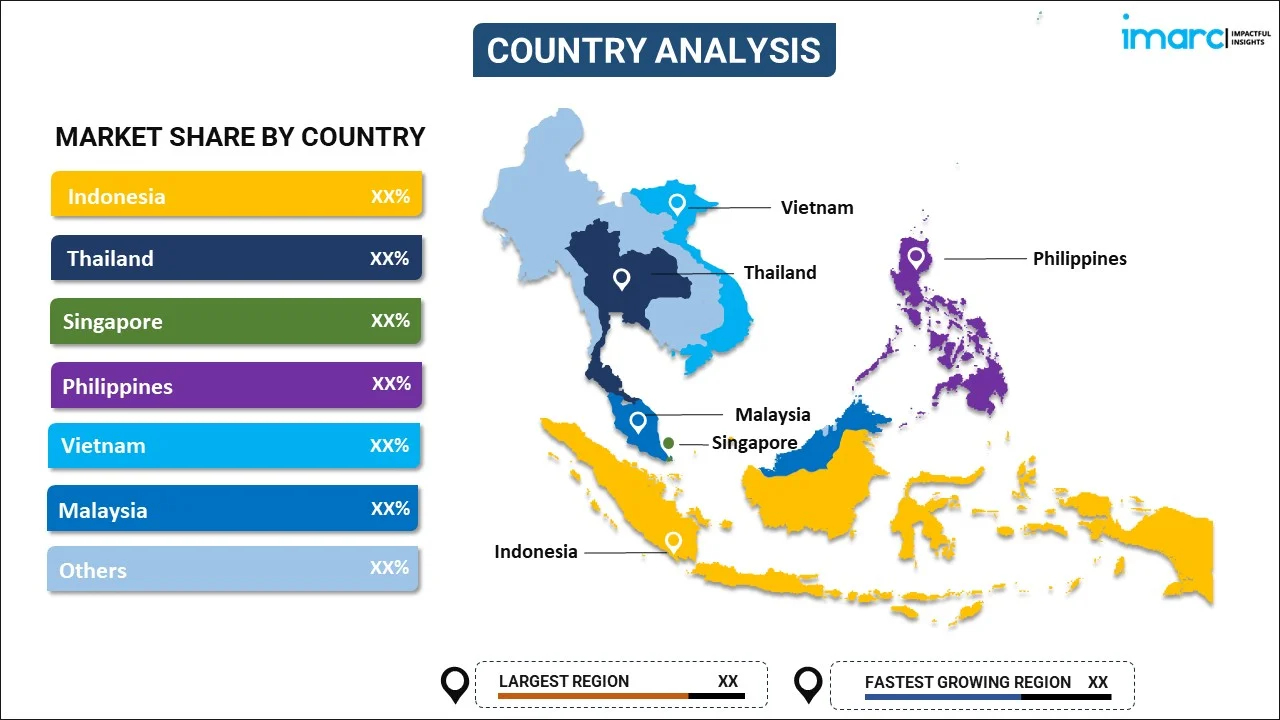
South East Asia Population Health Management Market Report by Component (Software, Services), Mode of Delivery (Cloud-based, Web-based, On-premises), End User (Healthcare Providers, Healthcare Payers, Employer Groups, Government Bodies), and Country 2024-2032
Market Overview:
South East Asia population health management market size is projected to exhibit a growth rate (CAGR) of 23.00% during 2024-2032. The availability of vast amounts of healthcare data that allows organizations to make informed decisions and predictions about population health trends, is driving the market.
|
Report Attribute
|
Key Statistics
|
|---|---|
|
Base Year
|
2023 |
|
Forecast Years
|
2024-2032
|
|
Historical Years
|
2018-2023
|
| Market Growth Rate (2024-2032) | 23.00% |
Population health management (PHM) is a healthcare approach that focuses on improving the health outcomes of a defined group of individuals. It encompasses a range of strategies aimed at optimizing the health of a community or population, rather than just treating individuals when they are sick. PHM involves analyzing and addressing the various factors that influence health, including social, economic, and environmental determinants. By leveraging data analytics and technology, healthcare providers can identify at-risk populations, tailor interventions, and coordinate care to enhance overall well-being. Prevention and early intervention play pivotal roles in PHM, aiming to reduce the incidence of diseases and minimize the impact of chronic conditions. This proactive and holistic approach to healthcare seeks to enhance both the quality of care and the overall health of communities, ultimately leading to improved health outcomes and cost-effectiveness.
South East Asia Population Health Management Market Trends:
The population health management market in South East Asia is propelled by various factors that collectively underscore the growing importance of comprehensive healthcare solutions. Firstly, the increasing prevalence of chronic diseases acts as a catalyst, necessitating a shift from traditional reactive care to proactive and preventive strategies. Moreover, advancements in technology play a pivotal role in fostering the integration of data analytics and artificial intelligence to enhance decision-making processes. This technological evolution enables healthcare providers to harness big data for predictive modeling and risk stratification, optimizing resource allocation and improving patient outcomes. In addition to technology, the transition towards value-based care models further fuels the PHM market. The imperative to deliver cost-effective and high-quality care motivates healthcare organizations to adopt population health management solutions that emphasize holistic well-being. Furthermore, the emphasis on patient engagement and empowerment is a driving force, encouraging the adoption of PHM tools that facilitate communication, education, and self-management. Collaboration and interoperability between healthcare stakeholders are integral components of PHM's growth trajectory. Interconnected systems enable seamless information exchange, fostering coordinated care and reducing fragmented healthcare delivery. As the regional healthcare landscape continues to evolve, these interwoven factors collectively propel the PHM market forward in Southeast Asia, driving innovation and transformative change in healthcare delivery.
South East Asia Population Health Management Market Segmentation:
IMARC Group provides an analysis of the key trends in each segment of the market, along with forecasts at the regional and country levels for 2024-2032. Our report has categorized the market based on component, mode of delivery, and end user.
Component Insights:

- Software
- Services
The report has provided a detailed breakup and analysis of the market based on the component. This includes software and services.
Mode of Delivery Insights:
- Cloud-based
- Web-based
- On-premises
A detailed breakup and analysis of the market based on the mode of delivery have also been provided in the report. This includes cloud-based, web-based, and on-premises.
End User Insights:
- Healthcare Providers
- Healthcare Payers
- Employer Groups
- Government Bodies
The report has provided a detailed breakup and analysis of the market based on the end user. This includes healthcare providers, healthcare payers, employer groups, and government bodies.
Country Insights:

- Indonesia
- Thailand
- Singapore
- Philippines
- Vietnam
- Malaysia
- Others
The report has also provided a comprehensive analysis of all the major regional markets, which include Indonesia, Thailand, Singapore, Philippines, Vietnam, Malaysia, and Others.
Competitive Landscape:
The market research report has also provided a comprehensive analysis of the competitive landscape. Competitive analysis such as market structure, key player positioning, top winning strategies, competitive dashboard, and company evaluation quadrant has been covered in the report. Also, detailed profiles of all major companies have been provided.
South East Asia Population Health Management Market Report Coverage:
| Report Features | Details |
|---|---|
| Base Year of the Analysis | 2023 |
| Historical Period | 2018-2023 |
| Forecast Period | 2024-2032 |
| Units | US$ Million |
| Scope of the Report | Exploration of Historical and Forecast Trends, Industry Catalysts and Challenges, Segment-Wise Historical and Predictive Market Assessment:
|
| Components Covered | Software, Services |
| Modes of Delivery Covered | Cloud-based, Web-based, On-premises |
| End Users Covered | Healthcare Providers, Healthcare Payers, Employer Groups, Government Bodies |
| Countries Covered | Indonesia, Thailand, Singapore, Philippines, Vietnam, Malaysia, Others |
| Customization Scope | 10% Free Customization |
| Report Price and Purchase Option | Single User License: US$ 3699 Five User License: US$ 4699 Corporate License: US$ 5699 |
| Post-Sale Analyst Support | 10-12 Weeks |
| Delivery Format | PDF and Excel through Email (We can also provide the editable version of the report in PPT/Word format on special request) |
Key Questions Answered in This Report:
- How has the South East Asia population health management market performed so far and how will it perform in the coming years?
- What has been the impact of COVID-19 on the South East Asia population health management market?
- What is the breakup of the South East Asia population health management market on the basis of component?
- What is the breakup of the South East Asia population health management market on the basis of mode of delivery?
- What is the breakup of the South East Asia population health management market on the basis of end user?
- What are the various stages in the value chain of the South East Asia population health management market?
- What are the key driving factors and challenges in the South East Asia population health management?
- What is the structure of the South East Asia population health management market and who are the key players?
- What is the degree of competition in the South East Asia population health management market?
Key Benefits for Stakeholders:
- IMARC’s industry report offers a comprehensive quantitative analysis of various market segments, historical and current market trends, market forecasts, and dynamics of the South East Asia population health management market from 2018-2032.
- The research report provides the latest information on the market drivers, challenges, and opportunities in the South East Asia population health management market.
- Porter's five forces analysis assist stakeholders in assessing the impact of new entrants, competitive rivalry, supplier power, buyer power, and the threat of substitution. It helps stakeholders to analyze the level of competition within the South East Asia population health management industry and its attractiveness.
- Competitive landscape allows stakeholders to understand their competitive environment and provides an insight into the current positions of key players in the market.
Need more help?
- Speak to our experienced analysts for insights on the current market scenarios.
- Include additional segments and countries to customize the report as per your requirement.
- Gain an unparalleled competitive advantage in your domain by understanding how to utilize the report and positively impacting your operations and revenue.
- For further assistance, please connect with our analysts.
 Inquire Before Buying
Inquire Before Buying
 Speak to an Analyst
Speak to an Analyst
 Request Brochure
Request Brochure
 Request Customization
Request Customization




.webp)




.webp)












